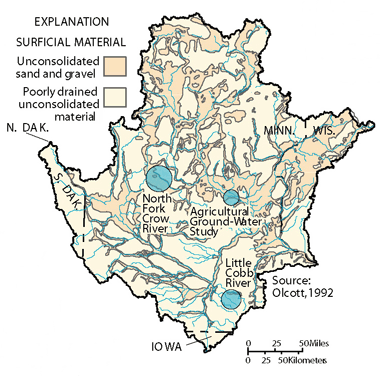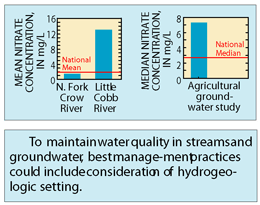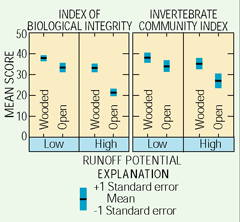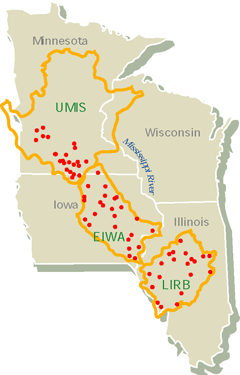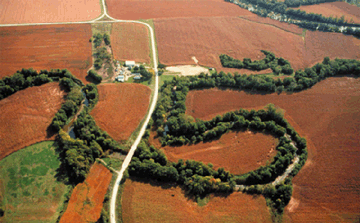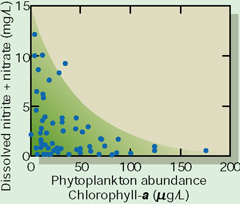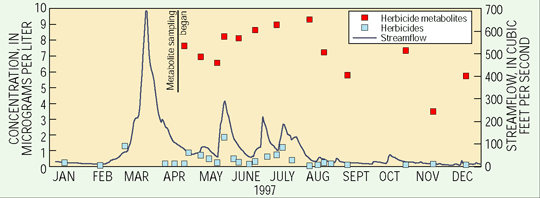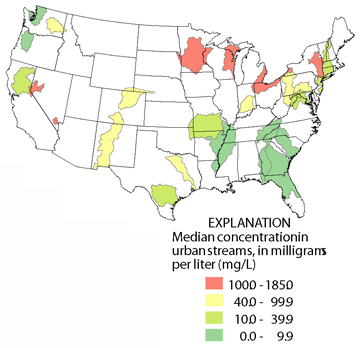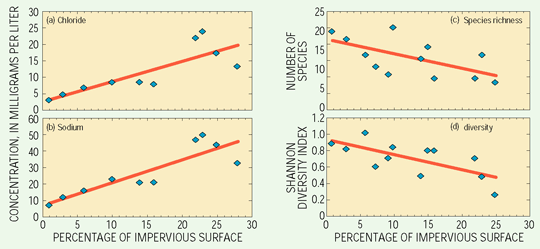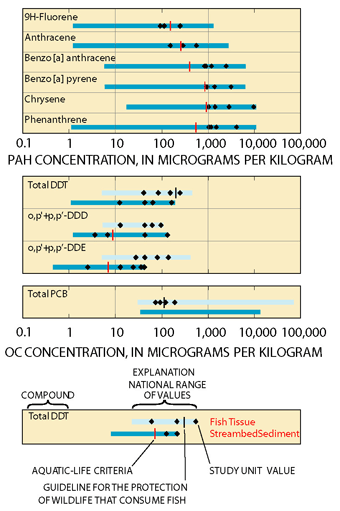MAJOR FINDINGS
This report presents work by the U.S. Geological Survey’s National Water-Quality Assessment Program to assess the quality of the Study Unit’s water and aquatic resources (fig. 6). The report summarizes historical data and Study Unit data collected during 1995–98.
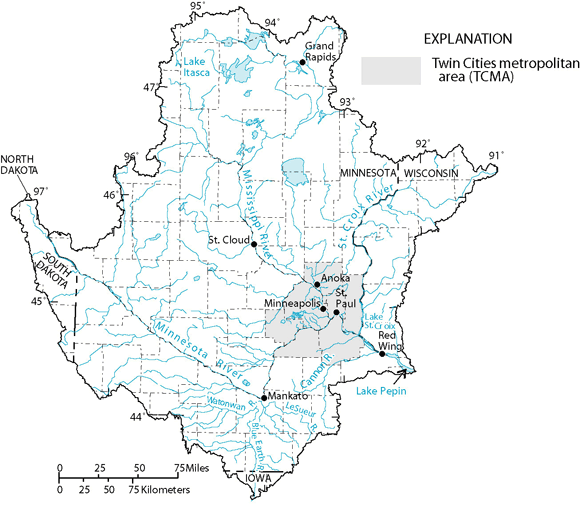 |
| Figure 6. Upper Mississippi River Basin Study Unit, Twin Cities metropolitan area, major rivers and streams, and selected cities. |
Land Use Influences Water Quality and Aquatic Biology
Point and nonpoint sources of nutrients, sediments, metals, and organic compounds from industrial, agricultural, and urban land uses are important water-quality issues in the Study Unit. Degradation of streams, including the loss of riparian habitat, reduction in fish populations, loss of habitat for bottom-dwelling organisms, eutrophication, and deterioration of the sanitary quality of streams is also important. Additional issues include the introduction of toxic substances, such as organic compounds and trace elements that accumulate in sediments and aquatic biota of the rivers. These contaminants can adversely affect the health of aquatic biota and may biomagnify in fish-eating birds and mammals.
Water-quality issues in the TCMA and other urban areas include surface-water contamination from urban runoff and discharge from industrial and wastewater treatment facilities and the introduction of toxic substances to ground water from industrial activities and nonpoint sources. In agricultural areas, including the Minnesota River Basin, water-quality degradation from artificial drainage systems and point and nonpoint sources of sediment, nutrients, and pesticides are of concern. Both urban and agricultural land uses contribute to the impairment of habitat and eutrophication in the Mississippi River in and downstream from the TCMA. In forested areas, including the St. Croix River Basin and upper reaches of the Mississippi River Basin, water is generally of better quality than elsewhere in the Study Unit. Maintaining the quality of water in the St. Croix River Basin is a priority for the National Park Service and the States of Minnesota and Wisconsin (Minnesota Department of Natural Resources and others, 1995).
Water Quality and Aquatic Biological Conditions Remain Relatively Undisturbed in Forested Areas
White pine forests originally covered much of the upper parts of the St. Croix River Basin and the Mississippi River Basin. These forests were logged during the mid 1800s to early 1900s and are now covered by second-growth forests.
Land-cover disturbances in these forested areas have been minimal, although small farms and towns are common, as is increased development for recreation. Water quality in these forested areas has been affected by minor applications of herbicides at small farms, tree farms, and in lakes (for weed reduction); discharges of waste-water effluent; leaks from septic systems; local stream-channel disturbances from forestry; and localized draining of wetlands. These activities result in small increases in nutrient, pesticide, suspended-sediment, and bacteria concentrations relative to natural conditions. Water-quality and aquatic-biological conditions have probably been affected less by human activities in the forested areas than in other areas of the Study Unit. Nutrients and pesticides did not exceed drinking-water standards and guidelines for human consumption in streams and in ground water in forested areas. Nitrate and phosphorus yields were low in streams in forested areas (table 1). Suspended-sediment concentrations, which can contribute to degraded water quality and habitat, also were low in streams draining forested areas compared to the rest of the Study Unit.
| Table 1. Nitrate and phosphorus yields in pounds per square mile per year in forest streams, 1996-98 | ||
| STREAM | NITRATE | PHOSPURUS |
| Namekagon River | 260 | —a |
| St. Croix River | 160 | 50 |
| a Yield was not calculated because concentrations were below the analytical reporting limits. | ||
Pesticides were periodically detected in streams and in shallow ground water in forested areas, but concentrations and detection rates were lower than in the rest of the Study Unit (Fallon and others, 1997; Fong, 2000). Trace-element concentrations in streambed sediments corresponded to the composition of the surficial glacial deposits (Kroening and others, 2000). For example, increased concentrations of copper in the forested areas are attributed to naturally occurring sources. Although bacteria concentrations in streams in forested areas were below the USEPA criterion for swimming (Kroening, 1999; U.S. Environmental Protection Agency, 1986), these waters would not be suitable for human consumption without treatment because bacteria counts may occasionally exceed USEPA drinking-water standards.
Physical modifications to streams, such as stream dredging or channelization, have been minimal in forested areas of the Study Unit. Consequently, aquatic communities are rich and diverse. Streams generally are more shaded than streams in other parts of the Study Unit, resulting in cooler water temperatures. Greater shading, cooler water, and lower concentrations of nutrients may limit algal productivity in these streams draining forested land. Algal communities in forest streams consist of species such as diatoms that are indicative of low nutrient and suspended-sediment concentrations.
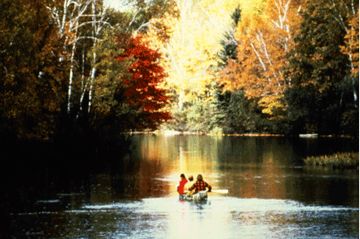 |
| Forests dominate the northern portion of the Study Unit. (Photograph courtesy of the National Park Service.) |
Increased urbanization and development for recreation contribute to degraded water quality and aquatic life. Management practices that could benefit the quality of streams in these areas include restoration of natural wetlands and riparian vegetation. Eliminating these practices would improve stream habitat and hydraulic conditions and improve the diversity of fish and invertebrate communities. Many programs and water-quality regulations are in place or are being considered to protect the quality of water in these areas, particularly in the St. Croix River Basin. One example is an effort to restrict increases in phosphorus to the St. Croix River to prevent excessive algal growth in Lake St. Croix (Holmberg and others, 1997).
Agricultural Activities Increase Nutrient and Pesticide Concentrations in Ground Water and Streams and Degrade Aquatic Biological Conditions
Agricultural areas of the Study Unit (fig. 4) include most of the Minnesota River Basin and parts of the Mississippi and St. Croix River Basins. In these areas, much of the land is used for production of row crops, primarily corn and soybeans. Many streams in agricultural areas have been straightened, ditches excavated, and land is commonly cultivated close to the streambanks. Most wetlands in agricultural areas have artificial drainage systems to increase crop production. Agricultural activities disrupt riparian zones in streams, contributing to erosion and runoff of agricultural chemicals and sediment.
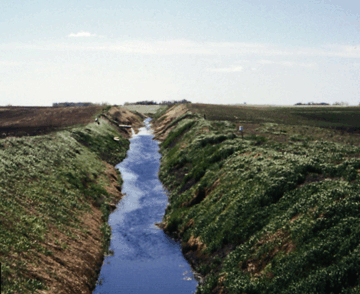 |
| Cultivation of land close to streams, artificial drainage, and stream straightening degrade water quality and aquatic habitat. (Photograph by James D. Fallon.) |
Nutrient concentrations in surface water and ground water (much of which eventually discharges to streams) were greater in agricultural areas than in other parts of the Study Unit (Payne, 1994; Kroening and Andrews, 1997; Ruhl and others, 2000). Commercial fertilizers and animal manure applied to agricultural land are sources of nutrients to streams and ground water (Kroening, 1998b; Ruhl and others, 2000). Nutrients that reach streams through artificial drainage or runoff accelerate the growth of algae and aquatic plants, resulting in eutrophication and diminished dissolved oxygen concentrations. In addition to affecting aquatic species, eutrophication also can cause taste and odor problems in water for domestic use.
Nitrate concentrations in streams draining the southern and southeastern parts of the Study Unit, most notably in the Blue Earth, Le Sueur, and Watonwan Rivers (Payne, 1994), have exceeded the drinking-water standard of 10 mg/L set by the USEPA to prevent methemoglobinemia in infants. Greater than one-half of the samples collected by Payne (1994) exceeded that drinking-water standard. Nitrate yields were greatest in agricultural streams (table 2). Nitrate yields were about 10 times greater in streams draining artificially drained, fine-grained surficial geologic deposits compared to streams draining coarse-grained deposits (Kroening, 1998a). Nitrate concentrations in shallow ground water are also greatest in the agricultural part of the Study Unit, and generally increased with the intensity of the agricultural activity and decreased with the water-table depth below land surface (Ruhl and others, 2000). (see “Nitrate in a National Context”)
| Table 2. Nitrate and phosphorus yields in pounds per square mile per year in agricultural streams, 1996-98 | ||
| STREAM | NITRATE | PHOSPURUS |
| North Fork Crow River | 1,400 | 190 |
| Little Cobb River | 15,000 | 330 |
Nitrate concentrations in the Study Unit are related to hydrogeologic setting and agricultural drainage. The application of commercial fertilizers and manure are sources of nitrate in streams and ground water. In general, nitrate concentrations in water are greatest in agricultural areas throughout the Nation (U.S. Geological Survey, 1999) including the Upper Mississippi River Basin. Yet, within agricultural areas within the Study Unit, nitrate concentrations vary due, to the hydrogeologic setting. Two rivers draining agricultural land in the Study Unit were frequently sampled for nitrate (1996-98). The North Fork Crow River is located in an area underlain by unconsolidated, coarse-grained sand and gravel deposits, that allow water and contaminants to infiltrate into ground water. The Little Cobb River is located on poorly drained unconsolidated material that limits the ability of water and contaminants to infiltrate into ground water. Artificial drainage systems (ditches and tiles) have been installed throughout these poorly drained soils to improve agricultural production. These systems also result in more direct transport of contaminants to nearby streams.
Although nitrate application rates from fertilizer and manure were similar in both river basins, nitrate concentrations in the streams were different. The nitrate concentration in the naturally well-drained North Fork Crow River was less than the national average for agricultural streams. In contrast, artificial drainage in the Little Cobb River Basin has contributed to nitrate concentrations in the stream, which rank among the top 2 percent of all streams sampled in the NAWQA Program. Differences between the nitrate concentrations in these two streams (see graph) reflect differences in their hydrogeologic settings. Although nitrate concentrations were low in streams draining surficial sand and gravel deposits, concentrations were greater in ground water--much greater than the national median. (see graph.) |
Phosphorus concentrations exceeding the goal of 0.1 mg/L recommended by the USEPA (1986) to prevent eutrophication were measured in agricultural streams (Kroening, 2000). Results from routine sampling showed this concentration was exceeded more frequently (about 75 percent of the samples) in streams fed by artificially drained soils that developed on fine-grained materials than in streams draining coarse-grained materials (about 30 percent of samples). Phosphorus yields were greatest in agricultural streams (table 2). Phosphorus yields were approximately 1.7 times greater in streams draining artificially drained, fine-grained surficial deposits than in streams draining coarse-grained deposits.
Median suspended-sediment concentrations typically ranged from 60 to 120 mg/L in agricultural streams (Kroening, 2000). Suspended-sediment concentrations were greater in streams in artificially drained, fine-grained surficial deposits compared to streams draining coarse-grained deposits. Physical disturbances to stream morphology, hydrology, and instream habitat have been caused by stream straightening, removal of riparian vegetation, drainage of wetlands, and tile drainage systems (see “Riparian Cover and Runoff Potential Affect Aquatic Biology,” and “Riparian Buffer Zones Affect the Quality of Midwestern Streams and Rivers,” p. 9). These disturbances also contribute to increased concentrations of suspended sediment, relative to streams in other land-use settings.
RIPARIAN COVER AND RUNOFF POTENTIAL AFFECT AQUATIC BIOLOGY
An investigation of 24 streams in the Minnesota River Basin during August 1997 determined that there were differences in fish- and invertebrate-community compositions due to both riparian cover and runoff potential (which increases when water infiltration decreases) (Stauffer and others, 2000; ZumBerge, 1999). An Index of Biotic Integrity (IBI--a measure of biological conditions based on several fish-community attributes), an Invertebrate Community Index (ICI--a measure of biological conditions based on several invertebrate community attributes), and species richness were used as measures of resource quality. Streams with wooded riparian cover had better IBI scores, ICI scores, and greater fish and invertebrate species richness than streams with open riparian cover indicating better resource quality. Streams with low runoff potential had better IBI scores, ICI scores, and fish species richness than streams with high runoff potential. These results suggest that streams with wooded
riparian cover had greater resource quality as indicated by fish
and invertebrate community measures. |
Pesticides frequently were detected in streams and shallow ground water in agricultural areas (Fallon and others, 1997; Fallon, 1998; Ruhl and others, 2000). Few concentrations exceeded applicable drinking-water standards and guidelines or aquatic-life guidelines. Herbicides were detected more frequently than insecticides. Pesticide concentrations in streams typically were greatest from May to July (Fallon and others, 1997). Ground-water samples with detections of one or more pesticides usually coincided with areas of shallow ground water close to the land surface (Hanson, 1998; Ruhl and others, 2000). Organochlorine insecticides were detected in fish tissue but not in streambed sediment (fig. 7, and see “Concentrations of Degradation Products of Agricultural Herbicides were Greater than Their Parent Compounds in Little Cobb River Near Beauford, Minn., 1997,” p. 10).
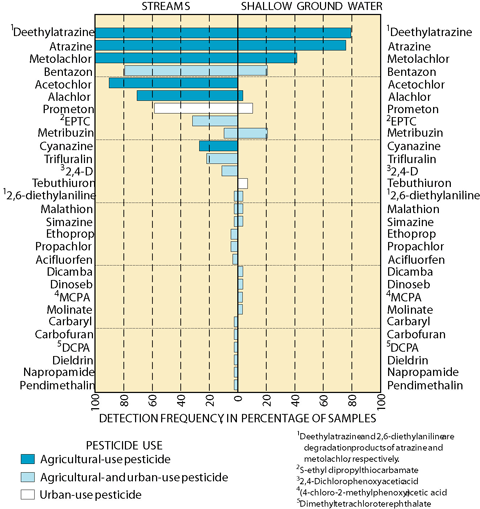 |
| Figure 7. Atrazine and its degradation product deethylatrazine were the most frequently detected pesticides in streams and shallow ground water in agricultural areas in the Study Unit. |
Algal, invertebrate, and fish communities have likely been affected by agriculture. Increased nutrients in agricultural streams have resulted in greater algal abundance and primary production. Algal communities were composed of a large proportion of blue-green algae that are commonly associated with high nutrient concentrations and are not suitable food sources for invertebrates (Kroening, 2000; Lee and ZumBerge, 2000). Contaminants from agricultural practices have likely affected invertebrate communities, which were moderately diverse and composed of mayflies and caddisflies that are relatively sensitive to contaminants. Total fish biomass was high in agricultural streams, probably in response to greater algal abundance and productivity. Although suspended-sediment concentrations were greater in the agricultural streams than in streams in other land-use settings, the presence of fish species such as stonecat and smallmouth bass indicate good water quality in terms of clarity (Goldstein and others, 1999).
Despite similar land use throughout the Corn Belt region of the Midwest, streams flowing through cropland differ considerably in their ecological characteristics, in part because of differences in riparian buffer zones (see text boxes). This conclusion is based on an investigation of 70 streams and rivers within three NAWQA Study Units in the upper Midwest during August 1997 (map shown at right; Sorenson and others, 1999; Porter, 2000a). Specifically, increases in tree cover in buffer zones were associated with aquatic biological communities indicative of good stream quality, reduced nuisance algal growths, and maintenance of sufficient dissolved oxygen concentrations to support diverse communities of aquatic organisms. For example, the number of aquatic insects indicative of good stream quality tended to increase with increases in percentage of tree cover, especially in sites where streamflow and dissolved oxygen conditions were favorable. Fish communities, sampled at 24 sites in the UMIS Study Unit, also indicated better overall conditions in streams with wooded riparian zones than those with more open canopy (Stauffer and others, 2000). Streams with less tree cover, and thus less shading, contained relatively large growths of phytoplankton (algae suspended in the water) at levels considered indicative of eutrophication (Porter, 2000b). Organic enrichment resulting from excessive algal production in some midwestern streams may reduce dissolved oxygen concentrations and be detrimental to other requirements of aquatic organisms. Shading from tree cover in riparian buffer zones may influence nutrient concentrations indirectly by reducing the growth of phytoplankton. In streams where phytoplankton were abundant (often where buffer zones were thin or lacking), dissolved nitrate concentrations were significantly lower (graph shown below; Porter, 2000b). The lower nutrient concentrations may result from uptake by the abundant phytoplankton. Thus, assessments of eutrophication would benefit from consideration of biological communities and the riparian zone, rather than being based solely on nutrient concentrations in the water.
|
| CONCENTRATIONS OF DEGRADATION PRODUCTS OF AGRICULTURAL HERBICIDES WERE GREATER THAN THEIR PARENT COMPOUNDS IN LITTLE COBB RIVER NEAR BEAUFORD, MINNESOTA, 1997 Eight degradation products (metabolites) of four commonly used agricultural herbicides (acetochlor, alachlor, atrazine, and metolachlor) were detected in samples collected from the Little Cobb River, an agricultural stream. Summed metabolite concentrations were always greater than summed parent compound concentrations. Metabolite concentrations were least during the fall and greatest during the summer. Four metabolites were present year round at substantial concentrations (metolachlor-ethane sulfonic acid and metolachlor-, acetochlor-, and alachlor-oxanytic acid). The affects of these metabolites on aquatic and human health are not known, their persistence and relatively high concentrations are a cause for concern.
|
Water Quality and Aquatic Biological Conditions are Adversely Affected in Urban Areas
The intensity of development in urban areas has adversely affected the quality of streams and ground water. Nonpoint-source contaminants to surface and ground water in urban areas originate from automobiles, road de-icing chemicals, construction, application of pesticides and fertilizers, atmospheric deposition, street debris in urban stream-water runoff, and animal and plant refuse (Hambrook and others, 1997). Major sources of contamination to ground water include spills or improper disposal of industrial or manufacturing chemicals, leachate from solid-waste landfills, and spills and leaks from petroleum storage areas and pipelines (Minnesota Pollution Control Agency, 1986).
Several factors can affect the occurrence and distribution of contaminants in surface and ground water in urban areas. Factors affecting urban streams include impervious surfaces, drainage of wetlands, construction of detention ponds, loss of riparian cover, and stream-channel modifications (Riley, 1998). Impervious surfaces cause greater peak streamflow rates of shorter duration from runoff than would occur naturally, and increase transport of contaminants from streets and parking lots to streams (Riley, 1998). These factors can increase water temperature and degrade habitat and water quality. Average water temperature in TCMA streams increased as the percentage of impervious surface increased (Talmage and others, 1999). Concentrations of nutrients, trace elements, chloride, sodium pesticides, and counts of bacteria were frequently greater in urban streams than those that occur naturally and may inhibit growth, reproduction, and diversity of aquatic biota (Klein, 1979; Pope and Putnam, 1997). Factors affecting shallow ground-water quality include the composition of surficial material and depth to ground water. Sand and gravel surficial materials increase infiltration and impervious surfaces decrease infiltration to ground water. Shallow ground-water quality generally improves with depth.
 |
| Minneapolis, Minn., the largest city in the Study Unit. (Photograph by Scott Murray Photography.) |
Streams and ground water in shallow aquifers in the TCMA contained elevated concentrations of sodium and chloride (Andrews and others, 1998), a result of the application of road de-icers. (see “Chloride in a National Context”)
Chloride concentrations in urban streams (Fallon and Chaplin, 2001) frequently exceeded the aquatic-life criterion of 230 mg/L (U.S. Environmental Protection Agency, 1999). Chloride concentrations were greater in streams with greater percentages of impervious surfaces and may have adversely affected fish diversity. (see “Urbanization Affects Fish Communities and Water Quality in Urban Streams of the Study Unit,” p. 12)
All nitrate concentrations in streams were less than the USEPA drinking-water standard of 10 mg/L (Kroening, 1998a, 2000). Less than 10 percent of nitrate concentrations in ground water exceeded the standard (Andrews and others, 1998; Fong and others, 1998). Nitrate and phosphorus yields in urban streams (table 3) were less than in agricultural streams (table 2) and greater than in forest streams (table 1). About 30–37 percent of the total phosphorus concentrations in urban streams exceeded the USEPA’s water-quality criterion of 0.1 mg/L (Kroening, 1998a, 2000). The greatest concentrations of nitrate in ground water were from samples of shallow ground water (unconfined surficial sand and gravel aquifers) (Kroening and Andrews, 1997). Areas with the greatest concentrations of nitrate are related to aquifer susceptibility and overlying land use. Nitrate concentrations tend to decrease with increased well depth (Hanson, 1998).
| Table 3. Nitrate and phosphorus yields, in pounds per square mile per year in streams in urban areas, 1996-98 | ||
| STREAM | NITRATE | PHOSPURUS |
| Shingle Creek | 400 | 130 |
| Nine Mile Creek | 510 | 140 |
Chloride concentrations in urban streams of the Study Unit were substantially greater than in most urban streams sampled throughout the Nation. Median chloride concentrations in ground water overlain by urban areas in the Study Unit were also greater than the national median, although not substantially. Elevated chloride concentrations result from runoff of de-icing chemicals applied to roads and highways during winter stonns (Granato, 1996). Because winter conditions are similar across the North-Central and Northeastern United States, the greater median chloride concentrations in other northern study units may also be at least partly the result of de-icing compounds. Sodium chloride (salt) is the primary de-icing compound applied to roads and highways in the Study Unit (Minnesota Department of Transportation, electronic commun., 2000). The environmental setting of the urban portion of the Study Unit, much of it covered with permeable sandy soils, wetlands, and lakes, may allow chloride to be more readily transported to and stored in lakes, wetlands, and shallow ground water (where chloride can persist) as well as being flushed directly to streams. Talmage and others (1999) reported that chloride concentrations were positively correlated with impervious areas (buildings and paved surfaces) in 13 urban streams of the Study Unit. The source of elevated chloride concentrations in urban streams in arid study units are likely from naturally occurring salts concentrated by the evaporation of surface water (Hem, 1992). Whereas de-icers are applied to roads in other study units throughout the Nation, concentrations in streams and ground water in this Study Unit are likely greater for several reasons. The amount of snowfall and seasonal duration of subfreezing temperatures may be greater in the Study Unit than most other study units. De-icing compounds other than sodium chloride may be used in other study units. Many samples had chloride concentrations that exceeded the aquatic-life criteria established by the U.S. Environmental Protection Agency (1999). Elevated chloride concentrations in streams may affect biological communities by altering the species composition. Urban streams in the Study Unit were dominated by fish and invertebrate species that are tolerant to degraded physical and chemical conditions, compared to other streams in the Study Unit. |
Dissolved-oxygen concentrations in most urban streams usually were greater than the minimum 5 mg/L aquatic-life criterion (U.S. Environmental Protection Agency, 1986) necessary for the protection of aquatic life. Dissolved-oxygen saturation in urban streams during the growing season was generally greater than forest streams and less than agricultural streams.
Pesticides were frequently detected in urban streams and shallow ground water (fig. 8); however, concentrations seldom exceeded applicable standards or guidelines (Andrews and others, 1998). Concentrations in shallow ground water were generally less than in surface water (Fallon and others, 1997; Andrews and others, 1998). Factors affecting pesticides in surface and ground water include land use, application methods, and atmospheric transport and deposition. In streams and shallow ground water, herbicides commonly used on road rights-of-way were detected (prometon and tebuthiuron), as were agricultural herbicides (atrazine and metolachlor). Insecticides were detected in almost 50 percent of stream water samples (Fallon, 1998) but in less than 5 percent of ground-water samples (fig. 8).
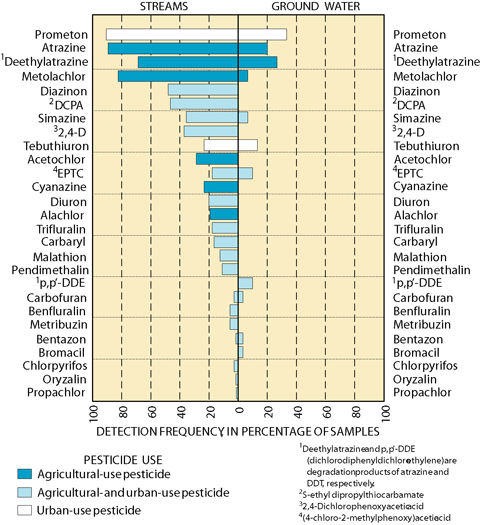 |
| Figure 8. Pesticides typically used in agricultural areas were frequently detected in streams and ground water in urban areas in the Study Unit. |
Volatile organic compounds (VOCs) were detected in surface and shallow ground water in the urban part of the Study Unit (fig. 9) (Andrews and others, 1995 and 1998). Some VOCs are suspected carcinogens and may be toxic to humans and wildlife. Although many VOCs were detected in urban streams, concentrations generally were below applicable standards and guidelines. The greatest concentrations occurred in stormwater runoff and winter low flows. The most frequently detected VOCs are components of petroleum products and by-products of petroleum combustion. These VOCs are contributed to streams from engine emissions to the atmosphere and from oil and gasoline leaks from vehicles to parking lots and roadways.
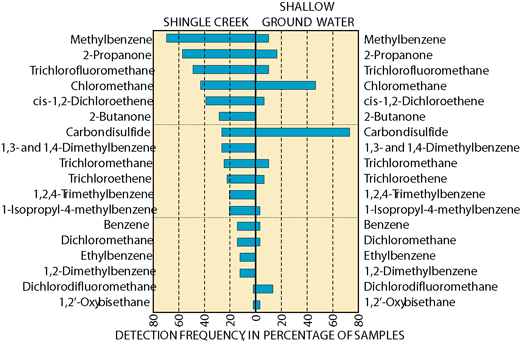 |
| Figure 9. More volatile organic compounds (VOCs) were detected in Shingle Creek (an urban stream) than in the shallow ground water in the same land-use setting, indicating that many VOCs break down before infiltrating the shallow ground water. |
Other contaminants such as polycyclic aromatic hydrocarbons (PAHs), organochlorine compounds (OCs), and trace elements are common in urban streams, frequently at concentrations greater than aquatic-life guidelines (McNellis and others, 2000; Talmage and others, 1999) (see “Organic Contaminants in a National Context” below). Urban activities and discharges also contribute to increased concentrations of trace elements (particularly cadmium, copper, lead, and zinc) in some urban streambed sediments. Elevated concentrations of some trace elements can be toxic to humans and aquatic life.
Fecal coliform counts differed widely among urban stream samples collected during September 1997, ranging from about 54 col/100mL (colonies per 100 mL) to more than 11,000 col/100 mL (Talmage and others, 1999). Fecal coliform counts at 8 of 13 sites exceeded the State of Minnesota freshwater standard for recreational use (200 col/100 mL) (Minnesota Pollution Control Agency, 1991). The greater bacteria counts may indicate localized leaking sewer or septic systems or animal waste.
Relatively low nutrient concentrations, stream shading, and contaminants may lead to low algal production in urban streams (Lee and others, 1999). However, nutrient concentrations are a concern because urban streams commonly drain to lakes that are more sensitive to eutrophication. The warmer temperatures and longer residence times of the water in lakes allow greater algal productivity. Invertebrate taxa that indicate good water quality, such as mayflies and stoneflies, were absent (see “Urban Biological Communities in a National Context”). Fish communities were characterized by a large proportion of species that can tolerate degraded water-quality conditions, such as central mudminnows and fathead minnows (Goldstein and others, 1999; Talmage and others, 1999). Factors that affect biological communities in urban streams include water and sediment chemistry and physical conditions such as hydrology and instream habitat.
Physical alterations, such as channelization and the high percentage of impervious area in urban basins, contribute to greater hydrologic variability (rapid streamflow increases and decreases during storm events). Waterfalls and dams are common in urban streams in the Study Unit and may be barriers to fish migration (Talmage and others, 1999). Migration barriers can limit the total number of fish species.
Polycyclic aromatic hydrocarbon concentrations in streambed sediment in urban areas are among the greatest in the Nation. Six polycyclic aromatic hydrocarbon compounds (PAHS) were detected at concentrations above U.S. Environmental Protection Agency (USEPA) aquatic-life criteria. Some are known carcinogens and are toxic to aquatic life. These compounds are generally by-products of combustion of fossil fuels or the burning of wood. Concentrations of PAHs at sites in other land uses were 10 to 100 times less than those in urban areas. Organochlorine detections are prevalent in urban areas. Some sites had concentrations greater than recommended for the protection of aquatic life or wildlife. Streambed sediment and fish tissue were analyzed for organochlorine compounds (OCs). Although uses of the insecticide DDT for mosquito control and polychlorinated biphenyls (PCBS) for industrial applications were discontinued in the 1970s, these compounds were still detected in urban streambed sediment in the Study Unit. Twelve of the 13 OCs (insecticides and PCBS) detected in streambed sediment in the Study Unit were found at urban sites. Three OCs including DDT, DDT metabolites (DDE and DDD), and total PCBs were detected in fish tissue at all urban sites in the Study Unit. Total DDT and metabolites in streambed sediment exceeded USEPA water-quality guidelines. PCB concentrations in fish exceeded USEPA standards for wildlife that consume fish. |
| Table of Contents || Previous Section || Next Section || Glossary U.S. Geological Survey Circular 1211 Suggested citation:
|


